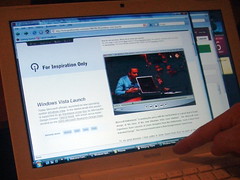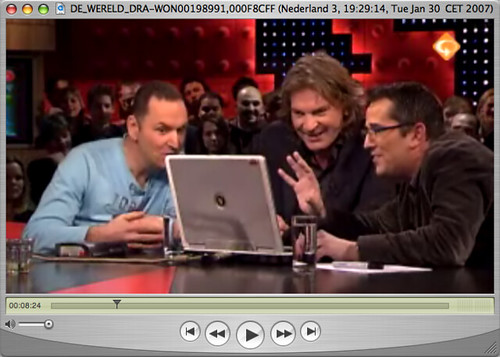Microsoft Netherlands is working the press with the fact that there is a great deal of Dutch design at the base of the new Windows Vista User Interface. The Microsoft User Experience team consists of seven designers from the Netherlands, most of them from Industrial Design. The most prominent name is their Design Director Tjeerd Hoek.
To my great pleasure I have gotten to know Tjeerd Hoek from my work on the 2003 Microsoft Research Interface Design Expo. A project in which we got to fly over to Microsoft headquarters in Seattle, WA and present our student’s work. From then on we have stayed in touch and had interesting email conversations on involving users , emotion, social networking and interface design gurus. Conversations that were most insightful.
An inspiring thesis from an inspiring dr. ir.
Tjeerd Hoek, Microsoft, on receiving my PhD thesis
Almost everybody agrees that the updated interface indeed looks smashing. The most heard criticism is that it looks too much like the Apple OS X operating system. Well, since 1989, I have been an almost religious Mac user and I visited their headquarters in 1994 – but reality is more differentiated.
What could Microsoft have done? In my opinion, the company could have made a much bigger step in their interface, especially in the context sensitive interfaces as they are implemented in the new Microsoft Office. But that would have resulted in a lot of resistance from its user base. Apple is blessed with a very innovative – and very critical – user base, which makes it easier to force new user patterns and bold steps onto it.
The biggest thing holding back the design of Microsoft, and the main cause of it being seen as too much of an Apple copycat, is that the program (or product) managers on the different parts of the Windows operating system suffer from death by risk-aversion. This makes it nearly impossible to introduce bold new features. Because only things that are either similar to things of the past or things that have been proven succesful at Apple are accepted. So, instead of the designers being asked to copy the Apple interface, it’s the program managers only selecting or accepting the features that they feel safe with. Within these boundaries the designers did a very good job, but you can really see the lack of risk in the details so well pointed out by David Pogue – in things like the calendaring application, the texturing in the chess game and the pan and zoom in the slideshows.
But lest not forget that Apple’s Dock, the command-tab application switching and the whole widget/gadget thing are not invented by Apple either.

Microsoft’s biggest problem however is the lack of integration of hardware and software. I have been running Windows Vista RC1 in a dual boot on my Apple MacBook and I continuously return to the Mac OS, mainly because I can use two-fingered trackpad scrolling, the built-in iSight and the Apple remote. This is their real amazing feat and we see Apple doing it again in the iPhone.
Though Bizz already did a roundup I will quickly do the same with a set of links to (mainly Dutch) newspaper articles and appearances in which Tjeerd had the chance to explain the complexity of the interface design process and to show off his taskbar drawing skills:
Newspapers
- AD Famous by Vista
- Trouw Vista déj\xC3\xA0 vu for Mac fans
- De Pers We want to add enjoyment factor (page 13)
- Brabants Dagblad Windows Vista feat of Dutch Design
Television appearance
- EénVandaag Microsoft Vista finally available
- De Wereld Draait Door Dutchman Tjeerd Hoek leads Microsoft Design Department also available on YouTube
Magazines online etc.
- Emerce Windows Vista partly ‘Dutch Design’
- Planet Vista expensive for gamers
- Dutch Cowboys 90 Minutes on Vista
- Molblog Apple only has to please Steve Jobs
- Marketingfacts Tjeerd Hoek at CES Las Vegas
- Bright Windows Vista
Cartoons
- Fokke & Sukke don’t want any Windows Vista
- René Leisink, Windows Vista: Better Design, Vulnerability remains
Update: The Tjeerd Hoek appearance on De Wereld Draait Door has resulted in somewhat of a row when Laurens Verhagen reported that Matthijs van Nieuwkerk was actually hired to host the official Windows Vista launch party in the afternoon – an activity which is now even under investigation. Oddly enough the Geenstijl moral crusaders picked up on the story and had a very interesting choice of visual material. The setting shows similarities with what happened in the afternoon.
Another update: Tjeerd himself is clearly not risk-aversive, as he explained at a panel on how to create a kickass in-house design team. Tjeerd likes his clients (i.e. program managers) to get nervous and his designers to cause trouble.
Did you find other relevant news items? Click the email link below.



